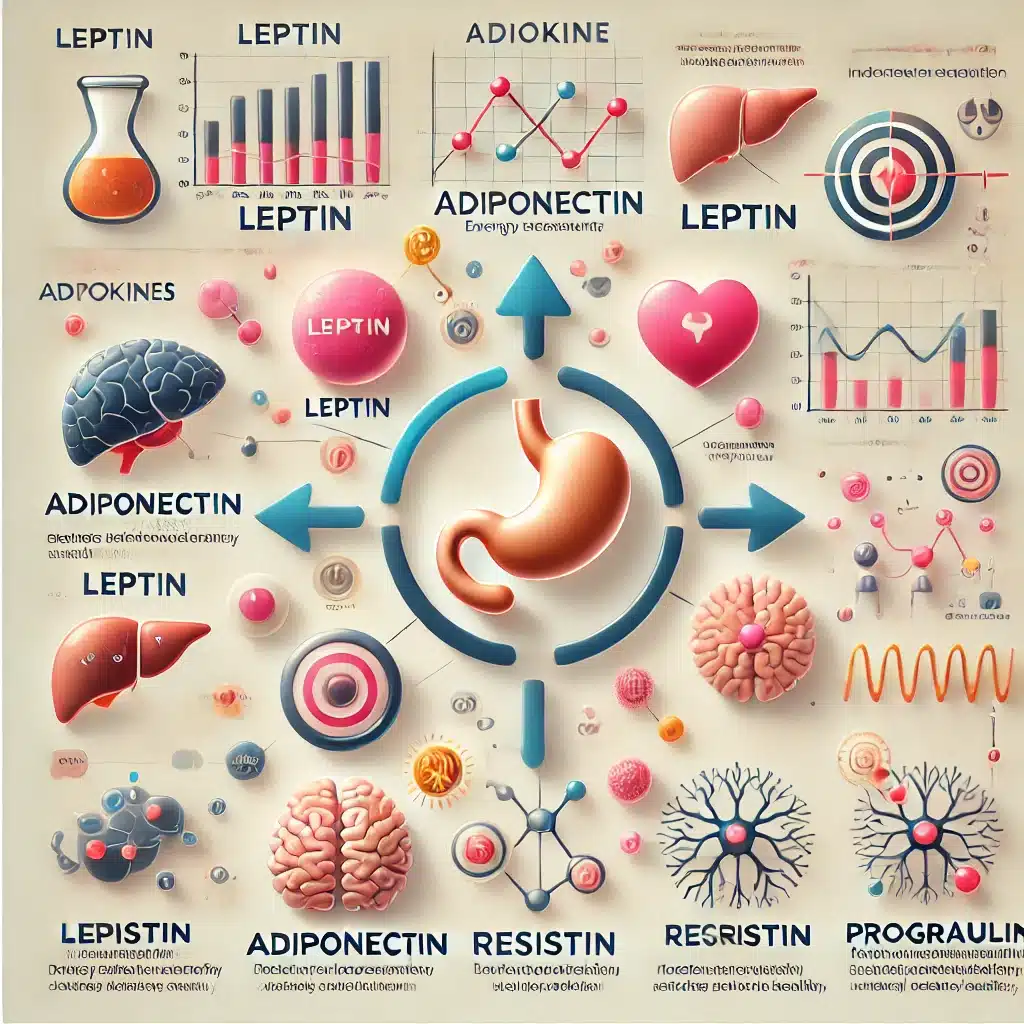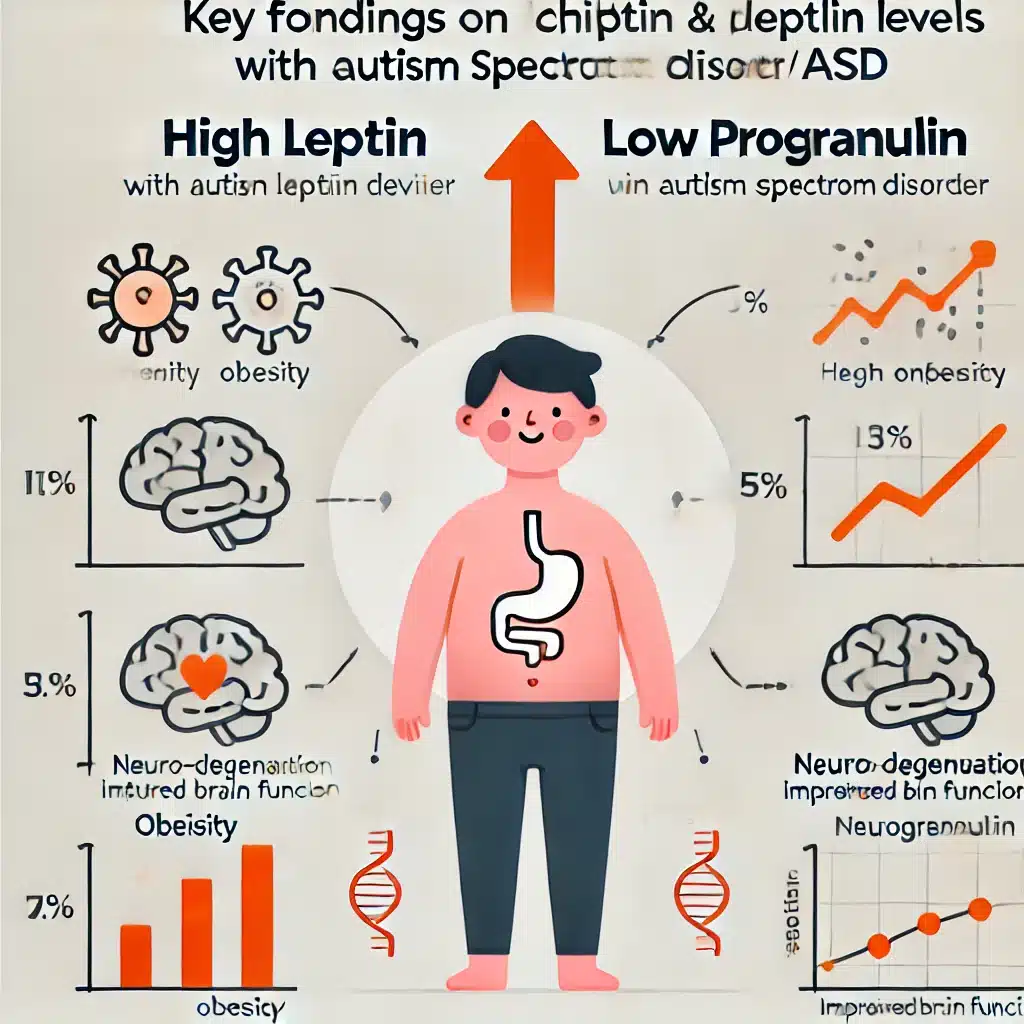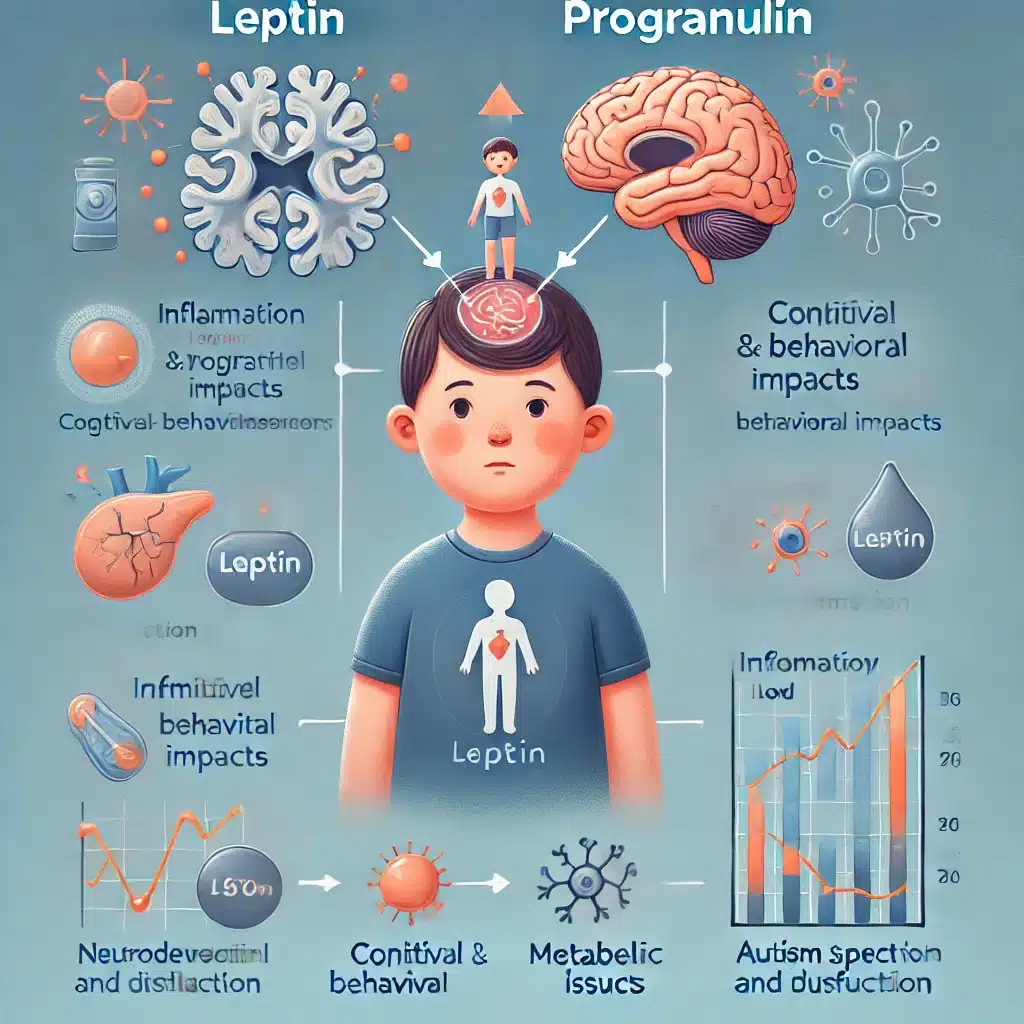Leptin levels are significantly increased in children with autism spectrum disorder (ASD) compared to healthy controls, suggesting a potential role in ASD pathology.
Highlights:
- Leptin Levels: Children with ASD have significantly higher serum leptin levels compared to healthy controls, as confirmed by both individual study results (p=0.0319) and meta-analysis (p<0.001).
- Progranulin Reduction: In addition to leptin, progranulin concentrations are significantly reduced in children with ASD, indicating a potential biomarker for the disorder.
- Adipokine Analysis: Other adipokines such as adiponectin, insulin, ghrelin, resistin, and dipeptidyl peptidase-4 showed no significant differences between ASD and healthy controls.
- Study Heterogeneity: Significant heterogeneity was observed among the studies, with meta-regression analysis indicating that publication year and latitude might influence the results.
- Potential Biomarkers: These findings highlight the importance of leptin and possibly progranulin as biomarkers for ASD, warranting further research into their diagnostic and therapeutic potential.
Source: BMC Psychiatry (2024)
Major Findings: Leptin & Adipokines in Autism Spectrum Disorder (ASD) (2024)
1. Increased Leptin Levels in ASD Children
Children with autism spectrum disorder (ASD) have significantly higher levels of leptin in their blood compared to children without ASD.
Leptin is a hormone primarily associated with regulating appetite and energy balance.
In this study, leptin levels were measured using a specific test called an enzyme-linked immunosorbent assay (ELISA).
The results showed a clear increase in leptin levels among children with ASD.
This finding was consistent across multiple studies analyzed together in a meta-analysis, reinforcing the significance of the result.
2. Decreased Progranulin Levels
Alongside leptin, the study found that progranulin levels were significantly reduced in children with ASD.
Progranulin is a protein involved in various cellular processes, including inflammation and neuron survival.
The reduction in progranulin levels suggests that it could play a role in the pathology of ASD.
However, more research is needed to fully understand its impact.
3. No Significant Changes in Other Adipokines
The study also measured other adipokines, such as adiponectin, insulin, ghrelin, resistin, and dipeptidyl peptidase-4, but found no significant differences in their levels between ASD children and healthy controls.
Adipokines are a group of proteins secreted by fat tissue that can influence inflammation and metabolism.
Despite the focus on leptin and progranulin, the lack of significant changes in these other adipokines suggests a more complex interaction at play that requires further investigation.
4. Study Variability & Influencing Factors
There was considerable variability (heterogeneity) among the studies included in the meta-analysis.
Factors such as the year of publication and geographical latitude of the studies appeared to influence the results.
This variability means that while the overall trend shows increased leptin and decreased progranulin levels in ASD, the differences in study designs, populations, and methods might affect the results.
Recognizing these factors is crucial for understanding and interpreting the findings accurately.
5. Potential of Leptin as a Biomarker
The consistent increase in leptin levels in children with ASD across various studies suggests that leptin could be considered a potential biomarker for ASD.
Biomarkers are measurable indicators of a biological condition or disease.
The elevated leptin levels in ASD children indicate that leptin might help in diagnosing or understanding the pathology of ASD.
However, its use as a standalone diagnostic tool is limited due to the observed variability and the need for further research to confirm these findings.
Potential Causes of Increased Leptin & Decreased Progranulin Levels in Children with Autism

1. Increased Leptin Levels
Inflammation
Leptin is known to have pro-inflammatory properties.
In children with ASD, chronic low-grade inflammation is a common observation, which could stimulate the production of leptin.
This inflammation could be part of the body’s response to various environmental and genetic factors associated with ASD.
Obesity & Metabolic Dysregulation
Children with ASD have a higher prevalence of obesity compared to their neurotypical peers.
Obesity is directly linked to increased leptin levels, as leptin is produced by adipose (fat) tissue.
This higher body fat content could be driving the elevated leptin levels observed in these children.
Leptin Resistance
There may be an element of leptin resistance in children with ASD, where despite high levels of leptin, its signaling pathways in the brain and body are not functioning properly.
This resistance might lead to a compensatory increase in leptin production in an attempt to overcome the signaling defect.
Genetic Factors
Certain genetic variations associated with ASD might also affect the regulation of leptin production and secretion.
These genetic factors could contribute to the higher leptin levels observed in ASD.
2. Decreased Progranulin Levels
Neuroinflammation & Immune Response
Progranulin is known to play a role in regulating inflammation and immune responses.
Reduced levels of progranulin could indicate an impaired anti-inflammatory response in children with ASD, contributing to the neuroinflammatory processes observed in the disorder.
Neuronal Health & Development
Progranulin is important for neuronal survival, growth, and repair.
Lower levels of progranulin could impair these processes, potentially contributing to the neurological and developmental issues characteristic of ASD.
Genetic Mutations
Mutations or genetic variations that affect the production or function of progranulin might be more common in individuals with ASD.
These genetic factors could lead to the decreased levels of progranulin observed in the study.
Metabolic Dysfunction
Metabolic dysfunction, which is often present in ASD, could also influence progranulin levels.
Disruptions in metabolic pathways might affect the production or stability of progranulin, contributing to its reduced levels.
Effects of High Leptin & Decreased Progranulin in Children with Autism

1. High Leptin Levels
Cognitive & Behavioral Effects: Elevated leptin levels can influence brain function by affecting the hypothalamus and other brain regions involved in regulating behavior and cognition. This could exacerbate symptoms of ASD, such as difficulties with social interaction, repetitive behaviors, and cognitive inflexibility.
Pro-inflammatory Effects: High levels of leptin are associated with increased inflammation. Chronic inflammation can affect brain development and function, potentially worsening the neurological and behavioral symptoms of ASD. This inflammatory state might also interfere with neurodevelopmental processes, leading to further cognitive and behavioral challenges.
Obesity & Insulin Resistance: High leptin levels are often associated with obesity and metabolic syndrome. Children with ASD and elevated leptin levels might be at higher risk for obesity-related issues, including insulin resistance and type 2 diabetes. These metabolic problems can impact overall health and quality of life, complicating the management of ASD symptoms.
Disrupted Leptin Signaling: Leptin resistance, where the body does not respond effectively to high levels of leptin, can lead to persistent hunger and overeating. This can further exacerbate obesity and metabolic issues, creating a cycle that is difficult to break and may negatively affect the child’s physical and mental health.
2. Lower Progranulin Levels
Brain Health & Function: Progranulin is crucial for neuronal survival, growth, and repair. Reduced levels of progranulin may impair these processes, leading to issues with brain development and function. This can contribute to the core symptoms of ASD, such as impaired social communication, restricted interests, and repetitive behaviors.
Anti-inflammatory Role: Progranulin has anti-inflammatory properties, and its decreased levels can lead to an imbalance in the inflammatory response. This dysregulation can contribute to neuroinflammation, which is commonly observed in ASD. Chronic neuroinflammation can have detrimental effects on brain structure and function, exacerbating the symptoms of ASD.
Neuronal Dysfunction: Lower progranulin levels can affect neuronal function and plasticity, potentially leading to cognitive deficits and behavioral issues. Children with ASD might experience difficulties with learning, memory, and executive function, which are critical for daily functioning and social interactions.
Neuronal Vulnerability: Progranulin is involved in protecting neurons from degeneration. Reduced levels of progranulin might increase the susceptibility of neurons to damage and death, which could contribute to the progressive nature of some neurodevelopmental disorders. This increased vulnerability might manifest as worsening cognitive and behavioral symptoms over time.
Conclusion: Adipokine Level Alterations in Autism
The study highlights significant alterations in adipokine levels, particularly increased leptin and decreased progranulin, in children with autism spectrum disorder (ASD).
Elevated leptin levels are associated with increased inflammation, metabolic dysregulation, and potential cognitive and behavioral impacts, which may exacerbate ASD symptoms.
Conversely, decreased progranulin levels may impair neuronal health, contribute to neuroinflammation, and increase susceptibility to neurodegeneration, further influencing ASD pathology.
These findings suggest that leptin and progranulin could serve as important biomarkers for ASD, offering new insights into its pathogenesis and potential therapeutic targets.
Future research is essential to explore these adipokine-related mechanisms and develop interventions to improve the quality of life for children with ASD.
References
- Study: Altered leptin level in autism spectrum disorder and meta-analysis of adipokines (2024)
- Authors: Lei Chen et al.







